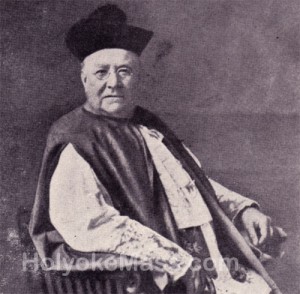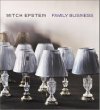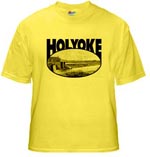by Laurel | February 6th, 2014
22 May 1904
The St. Jerome Anniversary
And Mgr. Harkin’s 40 Years
How the Parish Has Grown
Property Now Valued at $230,640 — Early Days Recalled —
The Priests Crusade Against Intemperance
Tomorrow will be jointly celebrated the first 50 years’ history of the St. Jerome Catholic Church and the 40th year of the ordination to the Catholic priesthood of its rector, Rev., and, by the grace of the Pope. Mgr. P. J. Harkins, who for 38 years has had charge of the destinies of the parish. In few cities can it be truly as said that the history of the city is as closely interwoven with the history of a church parish , as has been that of Holyoke with St. Jerome Church. The history of one in a sense has in large part been the history of the other, particularly in the earlier period; and that this has been so is due chiefly to the intense and dominating personality of Mgr. Harkins. It is doubly fitting that some note of Mgr. Harkin’s personal achievements should be made in this golden jubilee of the parish, for while it has been noted that Holyoke history cannot be properly written without that of the virile priest who has been master of the situation for these many years, the history of St. Jerome parish is little more than a record of the wise foresight and tireless activities of its pastor — for, in a sense Mgr. Harkins has been, and still is, the St. Jerome parish.
A type of the old parish priest in its best and highest development, Mgr Harkins has won from Catholic and Protestant alike in his many years of service a reputation for rugged honesty of purpose, indomitable courage, and unfettered strength in plain speaking that probably no other clergyman in Holyoke has ever approached. when sin and evil are concerned he has never acquired the art of speaking softly. In a time in the history of the city when drinking liquor was almost if not quite universal and accepted as a social rite, Mgr. Harkins, then plain Rev. Mr. Harkins, hesitated not a moment to denounce the vice of drunkenness and the bad effect of drinking in scathing terms; to start a society totally opposed to the use of liquor in any form, and day in and day out to life up his voice against that which is recognized today as one of the greatest curses of modern civilization. The St. Jerome temperance society is a monument to this line of his work. And the voice of Holyoke’s grand old man of the Catholic priesthood has never been silent in the presence of evil needing correction or of sin that needed rebuke. In 38 years of assailing of evil perhaps not all he has said has been wise, for priests are human, and human judgement is not infallible; but even when doubt might have been raised as to the wisdom of attach, even those who writhed under it have been willing in the great majority of cases to admit the sincerity of the motives that underlay it; and good has come, in that men were brought to think of the causes that underlay the evil assailed, and in due time reforms came about by reason of it, largely often if not wholly.Of the early parish days there are many legends that have come down as to the physical courage of Mgr. Harkins, which has always been equal to his boundless moral courage. Indeed, it is freely said by his parishioners who know him best that he absolutely does not know what fear is. One incident is illustrative: A man crazed by drink was beating his wife and terrorizing his neighborhood. An officer sent up was hurled down a flight of stairs and injured. Father Harkins was sent for, and, followed by a couple of constables, climbed the stairs and entered the room, to find the man, who had heard of his approach, hiding under the bed. The story also goes that the good father brought his cane down upon the man’s shoulders in no uncertain fashion, which may or may not be true, but is quite probable. Another fact that has brought terror to evil-doers has been that the St. Jerome priest is an observant man and about among the people and the streets of the city. Even to this time hardly a pleasant day goes by that he does not walk a long distance about the city, noting progress of building or improvement, so that nearly all of his knowledge of men and affairs comes first hand, and his original comments in conversation almost always pierce the core of the matter. Impatient of circumlocution and tedious phrase, his is a character that would have pleased old Commodore Vanderbilt, of whom it is related that whenever he received a letter of more than a half dozen lines, he would toss it over to his secretary and say, “Here, see what the fool is driving at and tell me the gist of it.” The ability to get at the gist of matters. to drive at the heart of evil from sure fats obtained first hand has been characteristic of the man throughout his entire Holyoke career.
Outside of his parish life at Holyoke to which he came in 1866. there is but little to be written. He was ordained at Laval University, Quebec, May 22, 1864, and for the two following years served as assistant pastor to Rev. Patrick Strain in Chelsea and Lynn, from which place he was assigned to Holyoke, his territory covering South Hadley Falls as well. The pioneer work had in part been done, but only the beginnings made; at that time the splendid growth of the city of Holyoke was but dimly foreshadowed in men’s minds; the few who looked confidently into its future were regarded more as dreamers than practical men. His people were then a poor people, there was much that must needs be done, and little of the wherewithal with which to do, and financial problems as well as spiritual and temporal, pressed upon him. But the man for the place had been found and with untiring energy, with high courage and indomitable perseverance he took up the burden of his work, with what signal success is common knowledge of today. Today tolerance has largely outgrown the bitter intolerance he faced when he first made Holyoke his home; all races, creeds, and conditions of people join together to honor his work and signify their appreciation of his service and example; in the larger sense the whole city is his parish, and his character, his life and his deeds are a matter of honest pride to Holyoke sons and daughters here and elsewhere.
Adapted from The Springfield Republican.









